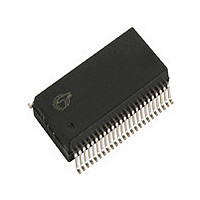CY7C63413-PVXC Cypress Semiconductor Corp, CY7C63413-PVXC Datasheet - Page 12

CY7C63413-PVXC
Manufacturer Part Number
CY7C63413-PVXC
Description
Manufacturer
Cypress Semiconductor Corp
Datasheet
1.CY7C63413-PVXC.pdf
(32 pages)
Specifications of CY7C63413-PVXC
Cpu Family
enCoRe II
Device Core
M8C
Device Core Size
8b
Frequency (max)
12MHz
Interface Type
USB
Program Memory Type
EPROM
Program Memory Size
8KB
Total Internal Ram Size
256Byte
# I/os (max)
24
Number Of Timers - General Purpose
1
Operating Supply Voltage (typ)
5V
Operating Supply Voltage (max)
5.25/5.5V
Operating Supply Voltage (min)
4/4.35V
Instruction Set Architecture
RISC
Operating Temp Range
0C to 70C
Operating Temperature Classification
Commercial
Mounting
Surface Mount
Pin Count
48
Package Type
SSOP
Lead Free Status / Rohs Status
Compliant
Document #: 38-08027 Rev. *B
Table 5. Port 3 Data
Table 6. DAC Port Data
Port 3 has eight GPIO pins. Port 3 (8 bits) can be configured
as inputs with internal pull-ups, open drain outputs, or tradi-
tional CMOS outputs. An open drain output is also a high-
impedance input. Port 3 offers high current drive with a typical
current sink capability of 12 mA. The internal pull-up resistors
are typically 7 kΩ.
Note: Special care should be exercised with any unused GPIO
data bits. An unused GPIO data bit, either a pin on the chip or
a port bit that is not bonded on a particular package, must not
be left floating when the device enters the suspend state. If a
GPIO data bit is left floating, the leakage current caused by the
floating bit may violate the suspend current limitation specified
by the USB Specification. If a ‘1’ is written to the unused data
bit and the port is configured with open drain outputs, the
unused data bit will be in an indeterminate state. Therefore, if
an unused port bit is programmed in open-drain mode, it must
be written with a ‘0.’ Notice that the CY7C63613C will always
require that data bits P1[7:4], P2[7:0], P3[3:0] and DAC[7:0] be
written with a ‘0’.
Table 7. Port 0 Interrupt Enable
Table 8. Port 1 Interrupt Enable
Table 9. Port 2 Interrupt Enable
Table 10.Port 3 Interrupt Enable
DAC[7]
P3[7]
P0[7]
P1[7]
P2[7]
P3[7]
R/W
R/W
W
W
W
W
Addr: 0x03
Addr: 0x30
Addr: 0x04
Addr: 0x05
Addr: 0x06
Addr: 0x07
DAC[6]
P3[6]
P0[6]
P1[6]
P2[6]
P3[6]
R/W
R/W
W
W
W
W
0.2 mA to 1.0 mA typical
DAC[5]
P3[5]
P0[5]
P1[5]
P2[5]
P3[5]
R/W
R/W
Low current outputs
W
W
W
W
Port 0 Interrupt Enable
Port 1 Interrupt Enable
Port 2 Interrupt Enable
Port 3 Interrupt Enable
DAC[4]
P3[4]
P0[4]
P1[4]
P2[4]
P3[4]
R/W
R/W
W
W
W
W
DAC Port Data
Port 3 Data
During reset, all of the bits in the GPIO to a default configu-
ration of Open Drain output, positive interrupt polarity for all
GPIO ports.
GPIO Interrupt Enable Ports
During a reset, GPIO interrupts are disabled by clearing all of
the GPIO interrupt enable ports. Writing a “1” to a GPIO
Interrupt Enable bit enables GPIO interrupts from the corre-
sponding input pin.
GPIO Configuration Port
Every GPIO port can be programmed as inputs with internal
pull-ups, open drain outputs, and traditional CMOS outputs. In
addition, the interrupt polarity for each port can be pro-
grammed. With positive interrupt polarity, a rising edge (“0” to
“1”) on an input pin causes an interrupt. With negative polarity,
a falling edge (“1” to “0”) on an input pin causes an interrupt.
As shown in the table below, when a GPIO port is configured
with CMOS outputs, interrupts from that port are disabled. The
GPIO Configuration Port register provides two bits per port to
program these features. The possible port configurations are
as shown in Table 11.
DAC[3]
P3[3]
P0[3]
P1[3]
P2[3]
P3[3]
R/W
R/W
W
W
W
W
DAC[2]
P3[2]
P0[2]
P1[2]
P2[2]
P3[2]
R/W
R/W
W
W
W
W
3.2 mA to 16 mA typical
DAC[1]
P3[1]
P0[1]
P1[1]
P2[1]
P3[1]
R/W
High current outputs
R/W
W
W
W
W
CY7C63413C
CY7C63513C
CY7C63613C
Page 12 of 32
DAC[0]
P3[0]
P0[0]
P1[0]
P2[0]
P3[0]
R/W
R/W
W
W
W
W
[+] Feedback










